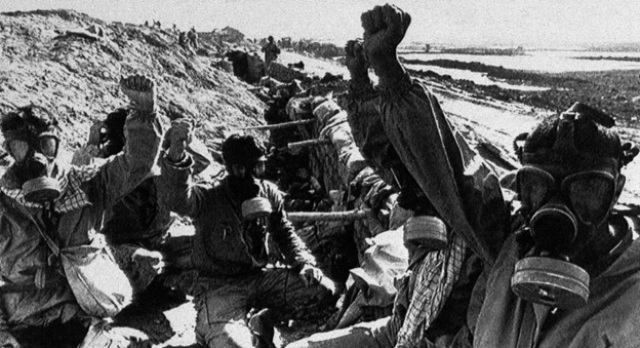In light of the discussion in the Western media on the topic of the participation of the US intelligence community in the armed confrontation between Russia and Ukraine on the side of the latter and, in particular, the possible transfer of targeting data to the Ukrainian coastal missile complex "Neptune", which struck the Russian missile cruiser "Moscow" on April 13, 2022, it will be interesting to recall the tacit participation of American intelligence in other regional armed conflicts.

Iranian soldiers wearing gas masks near Basra, 01/16/1987 (c) AP
According to the same sources of the American media and, as the press secretary of the US Department of Defense John Kirby assured on May 5, Washington allegedly has some restrictions, the so-called "red lines", on the issue of transmitting intelligence information to Kiev about the grouping of the Armed Forces of the Russian Federation participating in a special military operation in Ukraine. In particular, it is claimed that information about potential targets for strikes in the depths of Russian territory and about the movement and location of senior officials and military leaders is not transmitted to the Ukrainian side. In addition, the Americans allegedly do not participate in the selection of targets for strikes.
Meanwhile, as time passes, there is evidence that in real life for Americans there are no restrictions on ensuring national interests during armed conflicts. This was the case in the eighties of the last century during the Iran-Iraq War (1980-1988). The documents declassified to date and interviews with participants in the events of that time that appeared in the media indicate that Washington, at least since 1983, had data on the use of chemical weapons by the Iraqi regime of Saddam Hussein in the war with Iran (a toxic substance of skin-abscess action mustard gas), but did not bring them to the attention of the international community. Meanwhile, Tehran desperately needed documentary confirmation of its accusations.
In 1986, the US Department of Defense made a proposal to transfer intelligence information to Baghdad, but it was rejected because the CIA and the State Department "anathematized" Saddam Hussein and his "scumbags". However, the situation changed in 1987, when the CIA, relying on space intelligence data, reported to US President Ronald Reagan about the preparation of the Iranians for an offensive on the southern sector of the front in the area southeast of Basra. After reviewing the report, Reagan imposed a resolution addressed to Defense Secretary Frank Carlucci: "The victory of the Iranians is unacceptable."
This served as a starting point for the space and electronic intelligence data exchange program implemented subsequently by the American and Iraqi military departments. Colonel Rick Francona, who held the position of military attache of the American Embassy in Baghdad at that time, claimed that these were actually ready-made targeting data packages for Iraqi aviation, which, along with artillery, was also used by Baghdad to use chemical weapons (sarin nerve agent). In March 1988, chemical weapons were used against Kurdish rebels, and a month later - against Iranian troops during the liberation of the Faw peninsula. The defeat at Fao caused the cancellation of the offensive of Iranian troops on Basra and, in general, contributed to the end of the war on acceptable terms for Baghdad and Washington.
